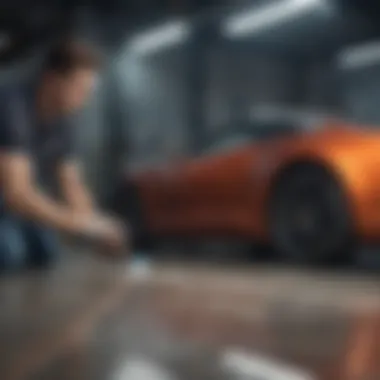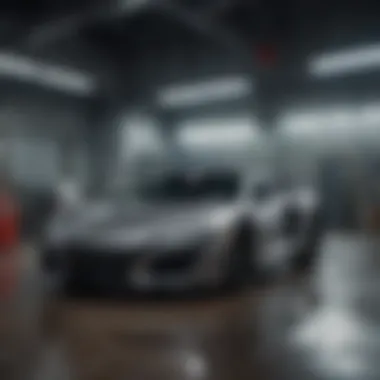Understanding the Costs of Car Paint Restoration


Intro
In this article, we will explore various aspects of car paint restoration costs. Key elements discussed will include factors influencing the pricing of restoration services, methods available, and a comparison between professional and DIY options. Expect a deep dive into materials required and payments involved, offering useful insights for car owners and aficionados alike.
Overview of Car Paint Restoration Costs
Assessing the overall costs of car paint restoration is crucial for prospective restorers. These costs differ based on numerous factors:
- Condition of the Paint: The more severe the damage, the more the restoration may cost. In cases of extensive fading or scratches, more intensive processes will be necessary.
- Type of Paint: The cost of paint itself varies. High-quality paints usually demand a higher price but often yield better results.
- Labor Costs: If you opt for professional services, labor costs can become the largest component of your budget. Different regions have different rates.
- Additional Services: Some services offer extras, like headlight restoration or minor dent removal, which can increase the total amount.
From the outset, understand that materials and tools also play a big vital role in the total financial commitment.
DIY Restoration: A Cost-Effective Alternative
Many car owners are tempted to undertake paint restoration themselves to save on costs. However, while DIY restoration might decrease downward costs, it may also come with risks:
- Skill Level: Lack of experience could lead to subpar results, potentially requiring additional professional work later-on.
- Initial Expense: Tools and materials purchased for DIY tasks can quickly add up. Understand all required items like spray guns, waxes, and quality paint.
Steps for DIY Paint Restoration
- Clean the vehicle to prepare the surface.
- Assess the type of damage present. Decide on repairs needed before proceeding.
- Choose suitable paint and treat accordingly.
- Apply primer first if required.
- Follow up with paint and sealer or wax for a finishing touch.
While DIY can save money, the final outcome may not match what a seasoned professional can provide.
When to Consider Professional Help
Professional paint restoration services can incur higher costs, yet they come with their own benefits. Key advantages include:
- Expertise: Trained professionals handle complex damages, ensuring detailed attention is given.
- Equipment: Suitable tools and machinery marks a stark difference in quality.
- Warranty: Certain professional services may guarantee results.
- Finish options: They provide an array of finish varieties to meet personal or vehicle-spec requirements.
In summar, choosing to restore paint on a car involves a balance between immediate costs, long-term benefits, and personal time invested. Whether opting for professional intervention or DIY attempts, a nuanced understanding of values remains vital. Ultimately, comprehend the significance of protecting your investment, whether it is through a calculated spending strategy or educated self-sufficiency.
Preface to Car Paint Restoration
Car paint restoration serves as a crucial aspect of automotive care. As vehicles age or encounter various types of damage, their paint may begin to lose its original luster. Restoration is not merely about aesthetics; it also preserves the vehicle's value and helps maintain its structural integrity. Understanding the associated costs allows car owners to make informed choices tailored to their individual needs.
Definition of Car Paint Restoration
Car paint restoration involves removing imperfections from a vehicle's paint surface. This can include addressing various issues such as scratches, oxidation, or ding. The goal is to restore the paint to its original state—a process that may employ different techniques, ranging from polishing to repainting. Each method of restoration varies significantly in cost linearly correlating not just to the extent of damage but also the techniques applied.
Importance of Aesthetic Maintenance
A vehicle's exterior often reflects the care and attention of its owner. This holds strong significance as it influences buyer perceptions during resale, potentially leading to enhanced resale value. A well-maintained vehicle can appear more appealing not only to potential buyers but also contributes to personal satisfaction for the owner. Moreover, neglected paint can result in deeper structural damage over time, indicating that prompt restoration can prevent further complications and higher costs down the road. Car paint restoration ultimately goes beyond aesthetics, positioning itself as a fundamental aspect of vehicle maintenance in a broader sense.
Investing in car paint restoration can be seen as both practical and economical for anyone who values their vehicle.
Cost Factors in Car Paint Restoration
The costs associated with car paint restoration are replete with several influencing factors. Understanding these aspects is essential for car owners who wish to reinstate their vehicle's visual appeal without incurring unexpected expenses. When discussing restoration, various elements ought to be taken into account. Each factor contributes uniquely to the final pricing. Hence, a detailed comprehension provides clarity and helps in making informed decisions.
Type of Damage
Scratches and Scuffs


Scratches and scuffs are among the most common forms of damage that a car's paint can endure. They typically arise from everyday incidents, such as contact with tree branches or unintentional brushes against other vehicles. These blemishes are critical as they relatively easy to address. A slight upside to a plethora of specific solutions exists as well, making it a beneficial topic to consider.
The uniqueness of scratches and scuffs lies in their sometimes superficial nature. Unlike other types, they often penetrate only the top layer of paint. Thus, an effective remedy may involve quick touch-up kits, delivering noteworthy results without extensive labor.
The downside to consider is that deeper scratches might require specialized repair that extends beyond simple touch-ups. While typically less costly than severe damage, the longevity of the fix might depend on the method chosen, influencing future aesthetics indirectly.
Oxidation
Oxidation is another noteworthy concern for car owners. This phenotype emerges when paint undergoes a chemical reaction over time, leading to discoloration and dullness. Many vehicle owners overlook oxidation's prevalence, yet it can significantly impact the vehicle's beauty and resell worth.
The characteristic trait of oxidation is its gradual development. Over time, exposure to UV rays, pollutants, and harsh weather can compound its effects. For this article, it serves as a pivotal area of growth for knowledge dissemination on maintaining trampoline aesthetics.
Addressing this issue offers its own advantages and disadvantages. While professional services can effectively remove oxidation, DIY solutions may contribute positively for those on tighter budgets. However, an incorrect DIY approach can further damage the surface, making cost management even trickier.
Chips and Dents
Chips and dents create another layer of complexity in car paint restoration. These are typically products of impact, such as roadway debris or minor accidents. They demand specific restoration methods due to their potential to expose the body's metal to rust if left unattended.
A key characteristic of chips is their potential severity; they can range from simply restorable to insurmountable. Therefore, these imperfections necessitate timely intervention.
While minor chips are often easily rectified, persistent dents or larger damages require professional service, often increasing cost. Each choice carries implications for overall maintenance costs down the line.
Size of the Vehicle
Vehicle size is a seemingly straightforward aspect of car paint restoration costs. Smaller vehicles usually demand lower expenses than their larger counterparts. Maattel/classic cars and SUVs incur sizeable increases for mass and working area, intensifying costs directly. Beyond simple scaling, aspects of the project's scope may escalate in complexity as car dimensions enlarge.
Before estimating, be mindful of which vehicle you own—han a coupe enligh folding hood trims openly avocaine a compact sedan—having necessary condition professionally scrutinized mitigates unplanned increases.
Quality of Paint and Materials Used
The quality of paint extremely influences restoration expenses. Some paints contain specific blends that afford better durability and aesthetics at premium prices. Hence, selecting paint based on final desired results should carefully counterpart values better to performance.
It becomes vital making fragments tradetrend on necessity such as hues, glows/siikynitespecficapplications so anoverall improvement; adjustments over preferred outcomes—unlike upfront suited solutionscheap can unintentionally delegatends marketing gone march indirectly.
Labor Costs and Expertise
Labor costs represent another pivotal aspect in understanding car paint restoration costs. The expertise and experience levels of professionals vary across locations. Highly renowned auto body shops with specialists guarantee quality work but often come at a steeper price. Conversely, less skilled establishments provide services at more accessible rates, but risk hindered result trends due too improperly eployed tools.
In summary, assessing labor variability enables potential outcomes simplicity in client expectations, thus accounting feedback enhancing value as capabilities earn remark over time.
Methods of Car Paint Restoration
The process of car paint restoration encompasses various techniques that help to regain a vehicle's aesthetic appeal. Understanding these methods is crucial not only for making an informed decision regarding your car but also for optimizing your investment. Ultimately, the approach taken can significantly influence the overall outcome and costs involved.
Professional Services
Full Repainting
Full repainting is one of the most comprehensive forms of car paint restoration. This method involves stripping down the vehicle's exterior, addressing all imperfections, and applying a complete new layer of paint. It is beneficial for those with extensively damaged paintwork or for individuals seeking a color change. The main characteristic of full repainting is its complete coverage, ensuring every inch of the car is revitalized.
However, this method is often considered a popular choice due to its long-lasting results. By using high-quality paints and modern techniques, full repainting can enhance a vehicle's appearance dramatically. The unique feature here is that it allows for full customization, which is appealing to many car enthusiasts. On the downside, the price can be a significant disadvantage, with costs typically on the higher end of the spectrum.
Touch-Up Services


Touch-up services involve applying paint to specific areas of a vehicle where paint damage has occurred. These services focus on smaller spots like scratches or chips. This method is ideal for those who do not want or need a complete repaint but still desire a fresh look. The key characteristic of touch-up services is their cost efficiency, making them a practical choice for minor imperfections.
This option is beneficial for maintaining a vehicle's aesthetic integrity while minimizing expenses. A unique feature of touch-up services is the precision involved, as technicians can closely match the specific paint color of the vehicle. Nevertheless, touch-up services may not provide the same depth of finish as full repainting, which may lead to a spotty appearance in certain cases.
Detailing and Polishing
Detailing and polishing are vital for the rejuvenation of a vehicle’s exterior without extensive paintwork. This method involves a thorough cleaning, compounding, and applying sealants or waxes. Detailing can enhance and protect the paint surface, making it a great choice for regular maintenance. The key characteristic of this method is its ability to restore shine and gloss without adding new paint.
This technique is often popular among car owners due to the professional finish it provides. One unique feature is the use of specialized tools and products designed to resolve surface imperfections. However, the disadvantage is that detailing may not address deeper paint flaws, so it's a more superficial method.
DIY Restoration Techniques
Using Paint Pens
Using paint pens offers a convenient and budget-friendly solution for minor paint touch-ups. It allows individuals to fill in small scratches or chips on their vehicles. The main characteristic of paint pens is their accessibility and ease of use. Many car owners prefer this method as it empowers them to tackle paint issues with minimal effort. One unique feature is that paint pens are specifically formulated to match car colors, making blending relatively straightforward. However, they may not be suitable for larger areas, as achieving an even finish can be challenging.
Buffing and Polishing
Buffing and polishing is a DIY method aimed at improving surface clarity and shine. It involves using a buffer and polish compounds to remove surface imperfections and restore gloss. The key characteristic of this method is that it can rejuvenate the look of both painted and non-painted surfaces. Buffalo and polishing is beneficial for enhancing a vehicle’s overall aesthetics without the need for costly paint repair. However, it requires careful technique to avoid damaging the substrate or creating uneven surfaces.
Spray Painting
Spray painting is another method that allows car owners to apply a new layer of paint on their vehicles conveniently. This technique involves using spray guns or cans, providing coverage to larger exterior areas. The main characteristic of spray painting is its versatility, allowing individuals to customize their vehicle's appearance or fix larger blemishes. This method can be popular for those with more significant paint restoration needs.
A unique feature of spray painting is the wide range of finishes and colors available. However, the challenge here is mastering the technique, as uneven application can lead to an unattractive finish. Furthermore, DIY application might not provide the same durability compared to professional methods.
In summary, understanding the various methods of car paint restoration is fundamental for making robust decisions regarding care and investment into any automobile.
Comparative Cost Analysis
Comparative cost analysis is a crucial section in understanding the financial implications of car paint restoration. This analysis enables individuals to assess their options by evaluating the costs associated with both professional services and do-it-yourself methods. By comprehending these cost dynamics, automotive enthusiasts and new buyers can make more informed decisions, selecting a restoration method that aligns with their budget and expected outcomes.
Professional vs.
DIY Restoration Costs
When considering car paint restoration, the choice between professional services and DIY restoration can significantly affect overall costs.
Professional Services
Choosing professional services means entrusting skilled technicians with the restoration. Prices can vary based on:
- Type of Damage: Deeper fixes may cost more.
- Quality of Materials: Premium paints or exclusive applicators will increase the price.
- Expertise Level: Highly-rated professionals may have a higher fee.
In general, hiring a professional for full repainting may cost between $1,000 to $3,500, while touch-up services or detailing could range from $100 to $1,500 based on vehicle size and color type.
DIY Restoration Techniques
On the other hand, DIY restoration techniques seem appealing owing to their lower initial costs. Basic supplies like paint pens, polishing kits, and spray paint can cost anywhere from $30 to $400. However, this cost does not include hidden expenses like missteps during the process or the need for additional materials if initial efforts go wrong.
Considering the time factor too is vital. DIY projects can take several hours or days depending on the extent of damage. Therefore, the real cost comes when time and potential failures are factored in.
Investing in professional services may cost more upfront. Yet, effective results may relieve future worries about possible follow-up needs arising from a poorly executed DIY job.


In a nutshell, comparing costs entails balancing upfront investments against potential long-term savings. Given the variances in individual skill levels and damage conditions, making the right choice is key to achieving desired aesthetic outcomes.
Regional Variations in Pricing
Car paint restoration costs also fluctuate based on geographical locations.
Key Considerations
- Labor Supply and Demand: Areas with higher skilled labor demand may see elevated wage rates.
- Local Business Practices: Businesses in regions with competitive markets may offer compelling deals or discounted packages.
- Material Sourcing: Prices for paint and consumables differ across regions, affecting overall restoration expenses.
For example, restoration costs in urban centers like Los Angeles and New York where demand tends to be high, will likely outpace costs found in smaller towns.
The End on Comparisons
Decisively, understanding the regional dynamics and method differences is essential when planning for car paint restoration. Balancing between professional and DIY approaches enables a deeper insight into what fits best both financially and effectively based on one's unique circumstances. Assessing your budget in juxtaposition to local services will clear the path toward making the most beneficial decision.
Evaluating Return on Investment
Evaluating the return on investment (ROI) when it comes to car paint restoration is crucial for any vehicle owner. It involves understanding the financial implications and potential benefits of restoring your vehicle's paint. Decisions pertaining to restoration should consider not just the immediate costs but also the long-term impact on the vehicle's value and aesthetics. This section explores why these considerations matter to car enthusiasts, new buyers, and anyone maintaining their car's appearance.
Enhancing Vehicle Resale Value
One of the main benefits of investing in car paint restoration is the potential increase in resale value. A vehicle that appears well-kept often commands a higher price in the used car market. Buyers tend to be attracted to vehicles that look pristine and show little signs of wear and tear.
Factors Impacting Resale Value
- Aesthetics: A freshly restored paint job creates an attractive vehicle. Buyers commonly inspect exterior conditions closely.
- Market Trends: Certain colors or finishes may appeal more during specific market trends. Keeping the vehicle updated could capture greater value.
- Brand Perception: Brands known for appreciating value may benefit costs more than others. High-quality restoration firms enhance credibility.
Considering this, every dollar spent on paint restoration could translate back to a product that can generate significantly more during its subsequent sale. Buyers are willing to pay for what they perceive as quality. Therefore, the initial restoration cost can turn into a wise investment in the long run.
Improving Vehicle Aesthetics
The aesthetic appeal of a vehicle can impact not just its resale value but also how the owner feels about their investment. A revitalized color and finish can transform how a vehicle is perceived. It embodies pride in ownership and provides personal satisfaction hearing about a beautiful exterior.',
Benefits of Aesthetic Restoration
- Confidence: A well-painted vehicle often leads to a psychological boost to drivers. Showing pride in one’s car reflects general self-image.
- Public Perception: An aesthetically pleasing vehicle resonates positively in social situations, enhancing ownership experience.
- Maintenance: Regular maintenance, including necessary restorations, reflects a proactive approach to overall vehicle care and function.
Furthermore, better aesthetics lead to rewarding visibility. Many owners derive great pleasure from the condition of their automobiles. It's often spoken about at gatherings, social circles, or events.
“Excellent condition leads to a community satisfaction that reflects bodily akin experiences.”
Thus, the intersection of personal satisfaction and increased investment value can yield profound returns, making car paint restoration not merely an expenditure but a strategic move in bettering current and future ownership experiences.
Culmination
In concluding this exploration of car paint restoration costs, it is essential to understand the various elements influencing both financial and practical aspects of the process. A car's exterior is not only a protective layer but also plays a critical role in maintaining overall value and appeal. Restoring paint enhances aesthetics and, ultimately, vehicle longevity.
Summarizing Key Points
The primary factors affecting the cost of car paint restoration include the severity and type of damage, the quality of materials, and whether the service is performed by professionals or as a DIY project. Each type of damage – whether it be scratches, oxidation, or chips – has unique implications on repair costs. Understanding durability can lead to choosing suitable paint types or restoration methods.
Consideration of vehicle size and labour costs, dictated by the technician's expertise, can significantly alter overall expenses. Always weigh the benefits of investing in professional services versus what could be achieved with DIY techniques.
Important Insight: Proper maintenance can dramatically increase a vehicle's resale value. A sound investment in paint restoration today may yield profitable returns in the future.
Final Thoughts on Cost Considerations
In assessing the costs related to car paint restoration, it's clear that timing, approach, and specifications will vary. Take into account your possession's history and your intentions for the vehicle. Aesthetic appeal is valuable, but understanding overall restoration context is equally crucial. Whether one opts for a professional job or ventured into a DIY project, informed choices are paramount. Assure that if genom work is chosen, time is taken to obtain quality index before dedicate time or money into the proccess.
Ultimately, restoration initiatives are not merely to improve visual appearance, but they reflect a ******** commitment to vehicle upkeep and performance. Such considerations amplify carecraft and can justify expenses undertaken.

